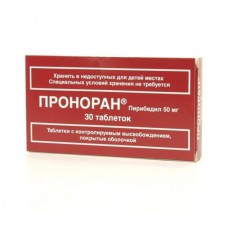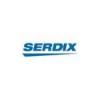Expiration date: 06/2026
The composition and form of issue:
Tablets, film-coated, controlled release. 1 tablet contains:
piribedil 50 mg
Excipients: sodium hydrogen carbonate, croscarmellose sodium beeswax white cochineal red (E124, Ponceau 4R) titanium dioxide (E171) Polysorbate 80 povidone silica colloidal anhydrous magnesium stearate sucrose talc
in a contour cell packing 15 PCs., in box 2 packaging.
Description pharmaceutical form:
Round, biconvex tablets, film-coated, red. The slight heterogeneity of staining, degree of gloss and the presence of small inclusions.
Pharmacokinetics:
Piribedil is rapidly and almost completely absorbed from the gastrointestinal tract and rapidly distributed.
Piribedil Cmax in plasma achieved through 3-6 h after oral administration of the dosage form with controlled release. The plasma protein binding is moderate (unbound fraction of 20-30%). Due to the low bond between piribedil plasma proteins the risk of drug interactions when used with other drugs low.
Plasma elimination piribedil is duvannyi in nature and consists of an initial phase and a second slower phase that leads to sustainable piribedil concentration in blood plasma for more than 24 hours
In the course of combined pharmacokinetic analysis showed that T1/2 piribedil after the on/in the introduction is on average 12 h and does not depend on the administered dose.
Piribedil is extensively metabolized in the liver and excreted primarily in the urine: 75% piribedil absorbed is excreted by the kidneys as metabolites.
Description pharmacological action:
The active ingredient piribedil is an agonist of dopaminergic receptors. Penetrates the blood flow to the brain, where it binds to dopaminergic receptors in the brain, showing high affinity and selectivity in relation to the dopaminergic receptor type D2 and D3. The mechanism of action of piribedil causes the main clinical properties of the drug for the treatment of Parkinson's disease both during the initial and later stages of the disease with exposure to all major motor symptoms. Piribedil in addition to effects on the dopaminergic receptor active antagonist of the two main &alpha-adrenergic receptors of the CNS (type &alpha2? &alpha2?). The synergistic action of piribedil as antagonist &alpha2-receptors and an agonist of dopaminergic receptors in the brain has been demonstrated in various animal models with Parkinson's disease: long-term use of piribedil led to a decrease in the severity of psoriasis, with similar efficiency with respect to reversible akinesia associated with Parkinson's disease.
During the pharmacodynamic studies in humans have shown a cortical excitation of dopaminergic electrogenesis type, as in waking, because during sleep, the manifestation of the clinical activity in relation to the various functions controlled by dopamine (this activity has been demonstrated using behavioral and psychometric scales). It has been shown that in healthy volunteers piribedil improves attention and vigilance associated with cognitive tasks.
Efficiency Pronoran as monotherapy or in combination with levodopa in the treatment of Parkinson's disease was studied in three double-blind, placebo-controlled clinical studies (2 studies compared to placebo and one compared with bromocryptine). The study included 1103 patient 1-3 stage on a scale Hyun and Yar (Hoehn & Jahr), 543 of whom received pronoran.
It is shown that Pronoran in a dosage of 150-300 mg/day is effective in the effect on the motor symptoms, with 30% improvement on a standardized rating scale of Parkinson's disease (UPDRS, part III — motor) for more than 7 months for monotherapy and 12 months in combination with levodopa. The improvement on part II of scal UPDRS — activities of daily living were assessed in the same values.
In monotherapy, a statistically significant proportion of patients requiring emergency treatment levodopa treated with piribedil (16.6 per cent) was lower than in the group of placebo patients (40,2%).
The presence of dopaminergic receptors in the blood vessels of the lower extremities explains the vasodilating effect of piribedil (increases blood flow in the vessels of the lower extremities).
Indications:
- subsidiary of symptomatic therapy in chronic violation of cognitive function and neurosensory deficit in the aging process (disorders of attention, memory, etc.)
- Parkinson's disease: monotherapy (with the forms, mainly including tremor) and in combination therapy with levodopa as initial and later stages of the disease, especially in forms that include tremor
- as adjuvant symptomatic treatment of intermittent claudication resulting from occlusive arterial disease of the lower limbs (stage 2 according to the classification Leriche and Fontaine)
- treatment of symptoms of ophthalmic diseases ischemic (decreased visual acuity, narrowing of the visual field, reduced contrast colors, etc.).
Contraindications:
- increased individual sensitivity to piribedil and/or auxiliary substances within the drug
- collapse
- acute myocardial infarction
- co-administration with neuroleptics (except clozapine)
- children up to age 18 years (due to lack of data).
Caution: due to the fact that the product contains sucrose, patients with fructose intolerance, glucose or galactose, patients with sucraseisomaltase deficiency (rare metabolic disorders) the drug is taken is not recommended.
Application of pregnancy and breast-feeding:
The drug is used mainly in elderly patients in whom the occurrence of pregnancy is unlikely. It has been shown that mice piribedil penetrates through the placental barrier and is distributed in the organs of the fetus.
In the absence of data, the drug should not be used during pregnancy and lactation.
Side effects:
Reported adverse reactions when taking piribedil are dose-dependent in nature and are primarily related to its dopaminergic activity. Moderate, occur mainly at the beginning of treatment and disappear after discontinuation of the drug.
Before the drug can occur following adverse reactions:
Gastrointestinal: frequent (&GE. 1/100, <1/10) — minor gastrointestinal symptoms (nausea, vomiting, flatulence), these adverse reactions are reversible in selecting the appropriate individual dose. The selection of doses by gradually increasing dosage (50 mg every 2 weeks to achieve a recommended dose) leads to a significant reduction of manifestations of these side effects.
CNS: frequently (&GE. 1/100, <1/10) — may include disorders such as confusion, hallucinations, anxiety or dizziness that disappears when the drug is removed.
Welcome piribedil accompanied by sleepiness, and in very rare cases may be accompanied by severe sleepiness in the daytime until the sudden sleep.
By SSS: very rarely (<1/10000) — hypotension, orthostatic hypotension with unconscious or malaise or labile blood pressure.
Allergic reactions: the risk of allergic reactions to the dye Carmine, which is part of the drug.
In patients with Parkinson's disease receiving therapy with dopamine agonists, especially in patients receiving high dosage of the drug in combination with levodopa, had a penchant for gambling, increased libido and hypersexuality, these manifestations were mostly reversible with dose reduction or interrupted treatment.
Drug interactions:
Contraindicated in combination
Antipsychotics (except clozapine). Mutual antagonism between the drugs used in the treatment of Parkinson's disease (antiparkinsonian drugs), and neuroleptics.
1. Patients with extrapyramidal syndrome caused by neuroleptics, should designate therapy and anticholinergic drugs should not be prescribed dopaminergic antiparkinsonian drugs (because of the neuroleptics block dopaminergic receptors).
2. Patients with Parkinson's disease receiving treatment of dopaminergic antiparkinsonian drugs and requiring the appointment of neuroleptics, do not continue to take levodopa due to increased manifestations of mental illness, and the neuroleptics block dopaminergic receptors.
3. Antiemetic neuroleptics (it is used antiemetic drugs, cause extrapyramidal symptoms).
Method of application and dose:
Inside, after eating, not liquid, squeezed 1/2 Cup water.
By all indications, except for Parkinson's disease — 50 mg (1 table.) 1 time a day. In more severe cases — 50 mg 2 times a day.
Parkinson's disease: monotherapy — 150-250 mg (3 to 5 table.) per day, divided into 3 doses, if necessary, taking the drug at a dose of 250 mg is recommended to take 2 table. 50 mg in the morning and afternoon and 1 table. in the evening in combination with levodopa — 150 mg (3 table.) per day, divided into 3 doses.
The selection of doses in the case of its increase is recommended to adjust the dose, gradually increasing it to 1 table. (50 mg) every 2 weeks.
Overdose:
Symptoms: vomiting, due to the action on chemoreceptor trigger zone, labile blood pressure (increase or decrease), dysfunction of the gastrointestinal tract (nausea, vomiting).
Treatment: cancel the drug, symptomatic therapy.
Special instructions:
Some patients (especially in patients with Parkinson's disease) in patients receiving piribedil sometimes suddenly arises a state of severe sleepiness until sudden sleep. This phenomenon is very rare, but nevertheless, patients driving the vehicle and/or working on equipment requiring a high degree of attention, should be warned about this. If you experience such reactions should consider dose reduction piribedil or discontinuation of therapy with this drug.
The dye Carmine, which is part of the drug, some patients increases the risk of allergic reactions.


